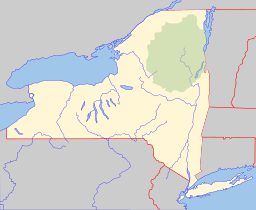Snowy Mountain (New York) facts for kids
Quick facts for kids Snowy Mountain |
|
|---|---|

Snowy Mountain as viewed from the north on NY Route 30
|
|
| Highest point | |
| Elevation | 3,899 ft (1,188 m) NGVD 29 |
| Prominence | 2,225 ft (678 m) |
| Listing | |
| Geography | |
| Location | Hamilton County, New York |
| Parent range | Adirondack Mountains |
| Topo map | USGS Indian Lake, NY |
Snowy Mountain is a tall mountain found in Hamilton County, New York. It was once called 'Squaw Bonnet'. The top of Snowy Mountain is the highest point in the whole county! Most maps say it's 3,899 feet high. But some newer measurements suggest it might be a bit taller, around 3,904 or even 3,908 feet.
This mountain is the tallest in the Adirondack Mountains south of the famous High Peaks region. That area has mountains over 4,000 feet. Snowy Mountain is also one of thirteen mountains in New York that stands out by more than 2,000 feet from its surroundings. Nearby mountains include Squaw Mountain to the northeast and Lewey Mountain to the southwest.
Contents
Water Flow from Snowy Mountain
Snowy Mountain is part of the area that drains into the Hudson River. This big river eventually flows into New York Bay. Water from different sides of Snowy Mountain takes different paths.
- The northwest side sends water into Little Squaw Brook. This brook then flows into the Cedar River and finally the Hudson River.
- The north side drains into Squaw Brook. This water goes into Indian Lake, then Lake Abanakee, and the Indian River, before joining the Hudson.
- The northeast side drains into Beaver Brook, which also flows into Indian Lake.
- The southeast slopes send water into Indian Lake through Griffin Brook, Forks Brook, Willow Brook, and Falls Brook.
The Fire Tower on Snowy Mountain
Snowy Mountain is home to the Snowy Mountain Fire Observation Station, often called a 'fire tower'. This tower was fixed up recently and is now a special historic place. It was added to the National Register of Historic Places in 2001.
Why Fire Towers Were Built
After big forest fires in 1903 and 1908, New York State started building observation towers. These towers were placed on high peaks like Snowy Mountain. Their job was to help spot and stop forest fires in the Adirondack Mountains.
History of the Snowy Mountain Fire Tower
- 1909: The first tower was built. It was a 15-foot-high tower made of logs, with a small log cabin nearby. A telephone line connected the tower to Indian Lake village, about 11.5 miles away.
- How it worked: When an observer saw smoke, they would call in the location. With reports from other towers, they could figure out the exact spot of the fire. This helped fire crews get there quickly.
- 1917: A stronger, 22-foot-high steel tower replaced the old log one.
- 1933: The steel tower was made even taller, reaching 33 feet. This helped observers see over the growing trees.
- 1971: The Snowy Mountain fire tower was closed. New York State decided that airplanes could do the job of spotting fires just as well.
- Later, the observer's cabin was removed.
Hiking Snowy Mountain
Because it's so high and has a restored fire tower, Snowy Mountain is a popular spot for hikers. The hike is nearly eight miles long. It also involves climbing over 2,000 feet in elevation. Even with the effort, many hikers say the amazing views from the top are worth it!
Early Climbs and Explorers
People have been climbing Snowy Mountain for a long time.
- 1771: The first known climb was by Archibald Campbell. He was a surveyor from Albany, New York. He was likely exploring the area for a large land purchase.
- 1872: Verplanck Colvin and his team climbed the mountain on August 4. They were working on the Adirondack Survey, mapping the region.
- 1882: Mills Blake, Colvin's assistant, and his crew climbed it again on November 7. They needed to finish some measurements for the survey. They were even on the summit on November 9 and 10! Since the walk to the mountain was long, they probably camped on the top for those last two days. Some think Colvin might have been with them on November 9. This climb is sometimes called the earliest 'winter' ascent, even though it was technically late autumn.
- 1885: Colvin made another climb on June 22 and definitely camped on the summit.
It's not known exactly when the hiking trail was built. It might have even existed before the fire tower was put up in 1909.
Rock Climbing at Snowy Mountain
Snowy Mountain also offers opportunities for rock climbing.
- Mid-1990s: Neal Knitel and Jonas Morelli tried to create a climbing route on the left side of the summit cliff. They didn't finish it because it was "too far" and they found "other stuff to do."
- 2002: Two different groups started working on climbing routes without knowing about each other. These were Karl Swisher and Sid Perkins, and Ed Palen and Bob Starinsky.
- By 2008: Seven high-quality climbing routes had been set up. These routes involve climbing on the rock face, using bolts for safety. The rock has many interesting features.
Snowy Mountain Boulders
Partway up the Griffin Brook area, you'll find the Snowy Mountain Boulders. This is a special collection of large rocks. It has the biggest collection of 'huecos' (natural pockets or holes in the rock) in the Adirondack Park. Dave Buzzelli first noticed this unique bouldering area in 2003. He was approaching the area for skiing. Since 2006, over 40 bouldering 'problems' (climbing challenges) have been created here.
Images for kids




